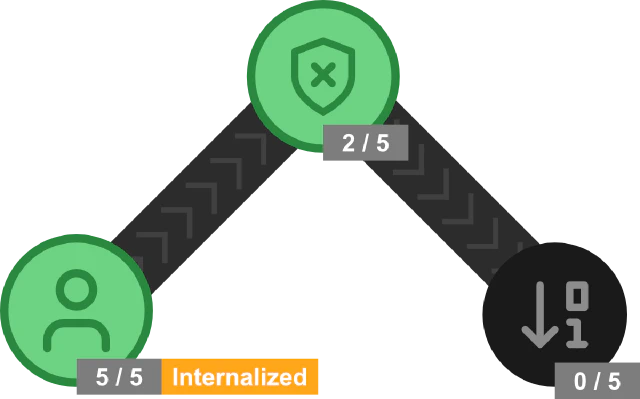Beginner's guide to executive functioning

After I discovered I have ADHD, I kept seeing the term “executive dysfunction” popping up. I had never heard of it before, but it seemed to explain some of the things I was struggling with.
I started learning more and found myself knee-deep in research papers and detailed articles that seemed to contradict each other.
This article is my attempt to understand what executive functioning is and how it relates to neurodiversity. I hope that after reading this article, you’ll be able to make sense of resources from more legitimate sources.
Before you continue reading
This article is for you if you have ADHD or you’re autistic. You may have heard the terms “executive function” or “executive dysfunction”, but you feel overwhelmed by the resources out there.
I should point out that I’m not certified in anything remotely relevant to this article. This is my attempt to make sense of the topic, and well, myself. I’ve based most of this article on the findings by Russell A. Barkley, Ph.D., a recognized authority on ADHD.
At the bottom of this page, you’ll find references to the resources that I’ve used to write this article.
I’ll update this article as I learn more, so if you have any feedback or corrections, please let me know.
The short version
Executive functioning is the ability to consciously control our thoughts, emotions, and actions, in order to achieve goals 1. It’s how we manage ourselves—both internally and externally.
Among other things, executive functioning allows you to:
- Plan and organize tasks
- Initiate tasks and stay focused on them
- Solve problems
- Suppress impulses
- Manage emotions
Executive dysfunction, or executive function deficit, means that one or more of the executive functions don’t quite work as they should.
Why do we have executive functions?
When children experience things happening around them, they react without thinking about whether it’s in their best interest to do so. As they get older, they eventually learn to self-regulate.
Self-regulation is an conscious action we direct at ourselves in an attempt to alter the future to our advantage 2.
For example, the child eventually realizes that talking loudly isn’t the best way to get what they want, so they lower their voice instead, hoping to improve the outcome.
As the child continues to develop, they learn more ways to self-regulate, also known as executive functions.
While self-regulation demands conscious effort, we eventually become so good at it that the people around us don’t notice anymore. It becomes internalized. By the time you’re an adult, these executive functions have become a well-oiled machinery, all working in harmony with each other.
If you’ve ever played a role-playing game, you may think of self-regulation as a branch in your skill tree. As you level up, you unlock new abilities, or executive functions. These can in turn be leveled up until they become internalized.

The 7 cognitive executive functions
The exact number of executive functions varies depending on who you ask. Barkley defines the following 7 cognitive executive functions, while others seem to combine these into smaller sets of functions.
- Self-awareness lets you assess your own abilities and limitations.
- Inhibition lets you practice self-restraint and suppress impulses.
- Non-verbal working memory lets you hold things like numbers or faces in your mind.
- Verbal working memory lets you hold words in your mind.
- Emotional regulation lets you suppress and dampen emotions.
- Motivational regulation lets you initiate and sustain effort and interest in what you’re doing.
- Planning and problem-solving lets you set and prioritize goals.
These executive functions develop one after the other, where each function depend on the previous ones to work well.
In reality, each executive function may be more developed than the others—or less. Having a great working memory doesn’t necessarily mean you’re great at problem-solving.

Executive dysfunction—when functions don’t function
The prefrontal cortex—the part of our brain that’s responsible for executive functioning—is the last part to fully develop. It’s not considered fully developed until the age of 25 3.
Some people don’t fully develop their executive functions until much later in life. Some never fully develop them. Executive dysfunction, or executive function deficit, means that one or more executive functions don’t work quite like they should.
For example, a person with executive dysfunction may experience the following:
- Impulse buying things they don’t need (inhibition)
- Difficulties suppressing their emotions (emotional regulation)
- Difficulties motivating themselves to work on a task (motivational regulation)
Even people who have properly developed executive functions may experience lapses now and then. This is perfectly normal, and not necessarily a sign of executive dysfunction.
In contrast, people with executive dysfunction may experience these difficulties on a daily basis.
Executive dysfunction in real life
In practice, deficits in multiple executive functions may have compound effects, making everyday task seem impossible sometimes.
Imagine you need to submit travel expenses for a business trip:
- You know that even with the receipt in hand, you forget the amount by the time you start typing it in (non-verbal working memory).
- As a result, you struggle to motivate yourself to even open the website (motivational regulation).
- You start feeling bad for not being able to something—that you perceive to be—simple, which rapidly escalates into depression (emotional regulation).
The brain chemicals that may hold the answers
Imagine that your brain is a big city with lots of buildings, roads, and cars driving around. And just like cities are made up of people, your brain is made up of neurons.
When neurons want to talk, they use different delivery companies, or neurotransmitters, to send messages to each other. It’s important that we have just enough of these. Too few, or too many, can have negative effects on our well-being.
While there are many different neurotransmitters, research has linked two of them to executive functioning: dopamine and norepinephrine.
Dopamine—you know you want it
Researchers have linked executive dysfunction with lower levels of dopamine, a neurotransmitter that plays a major part in the brain’s reward system.
Previously, researchers found a link between dopamine and pleasure—believing that dopamine is what makes us feel good. People even started calling it the “pleasure hormone”.
Today, we know that dopamine is more related to the anticipation of pleasure rather than pleasure itself 4—making motivation molecule a better nickname. Increased levels of dopamine make you seek out rewarding behavior. And once you experience it, the brain produces more—as a way of saying, “That felt good, let’s do it again!”
Too little may cause you to feel indifferent, unmotivated, and uninterested in sex 5.
Too much may cause you to be more aggressive, take more risks, and have an excessive sex drive.
Pay attention to norepinephrine
Also known as noradrenaline, norepinephrine causes you to be more alert. It tells you to wake up and pay attention. It lets you focus on everyday tasks 6.
Too little may cause lack of interest, low energy, and low blood pressure.
Too much may cause high blood pressure, heart palpitations, and headaches.
Things you can do manage executive dysfunction
If you’re struggling with executive dysfunction, you’ll want to increase the levels of dopamine and norepinephrine in your brain.
This section lists some known ways boost neurotransmitters 7.
Activities
- Exercising regularly
- Getting adequate amount of sleep
- Listening music or doing something that brings you joy
Food sources
- Eat more protein-rich foods, specifically those containing tyrosine.
- Eat less saturated fats.
- Eat more probiotics, such as fermented food.
Conclusion
For many, including myself, discovering terms like executive dysfunction can be a pivotal moment, shedding light on struggles that once seemed insurmountable.
In this article, we’ve explored what executive functioning is, how it develops, and what happens when it doesn’t work as it should. We’ve also looked at the brain chemicals that may play a role in executive functioning.
While research on executive functioning is still ongoing, with new discoveries being made, this article is intended to serve as a starting point—an invitation to better understand executive functioning. Executive dysfunction may look different from person to person, and it’s important to remember that everyone is unique.


